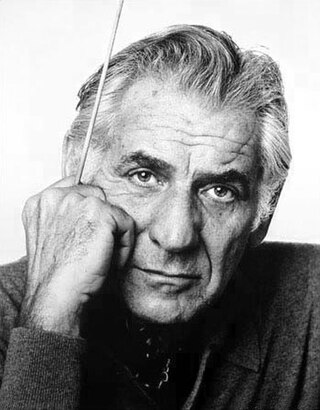
Leonard Bernstein was an American conductor, composer, pianist, music educator, author, and humanitarian. Considered to be one of the most important conductors of his time, he was the first American-born conductor to receive international acclaim. Bernstein was "one of the most prodigiously talented and successful musicians in American history" according to music critic Donal Henahan. Bernstein's honors and accolades include seven Emmy Awards, two Tony Awards, and 16 Grammy Awards as well as an Academy Award nomination. He received the Kennedy Center Honor in 1981.
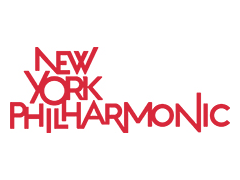
The New York Philharmonic is an American symphony orchestra based in New York City. Known officially as the Philharmonic-Symphony Society of New York, Inc., and globally known as the New York Philharmonic Orchestra (NYPO) or the New York Philharmonic-Symphony Orchestra, it is one of the leading American orchestras popularly called the "Big Five". The Philharmonic's home is David Geffen Hall, at New York's Lincoln Center for the Performing Arts.
The Columbia Symphony Orchestra was an orchestra formed by Columbia Records for the purpose of making recordings. In the 1950s, it provided a vehicle for some of Columbia's better known conductors and recording artists to record using only company resources. The musicians in the orchestra were contracted as needed for individual sessions and consisted of free-lance artists and often members of either the New York Philharmonic or the Los Angeles Philharmonic, depending on whether the recording was being made in Columbia's East Coast or West Coast studios.
Julius Baker was one of the foremost American orchestral flute players. During the course of five decades he concertized with several of America's premier orchestral ensembles including the Chicago Symphony and the New York Philharmonic Orchestra.
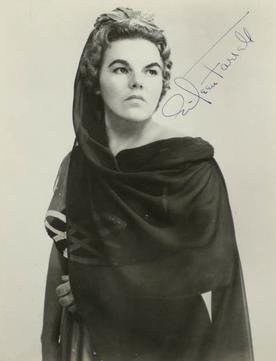
Eileen Farrell was an American soprano who had a nearly 60-year-long career performing both classical and popular music in concerts, theatres, on radio and television, and on disc. NPR noted, "She possessed one of the largest and most radiant operatic voices of the 20th century." While she was active as an opera singer, her concert engagements far outnumbered her theatrical appearances. Her career was mainly based in the United States, although she did perform internationally. The Daily Telegraph stated that she "was one of the finest American sopranos of the 20th century; she had a voice of magnificent proportions which she used with both acumen and artistry in a wide variety of roles." And described as having a voice "like some unparalleled phenomenon of nature. She is to singers what Niagara is to waterfalls."
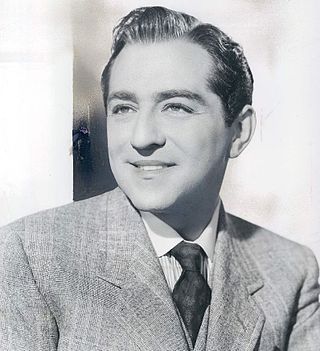
Robert Merrill was an American operatic baritone and actor, who was also active in the musical theatre circuit. He received the National Medal of Arts in 1993.

The Buffalo Philharmonic Orchestra is an American symphony orchestra located in Buffalo, New York led by Music Director JoAnn Falletta. Its primary performing venue is Kleinhans Music Hall, which is a National Historic Landmark. Each season it presents over 120 classical series, pops, rock, youth, and family concerts. During the summer months, the orchestra performs at parks and outdoor venues across Western New York.

Dimitri Mitropoulos was a Greek and American conductor, pianist, and composer.

Jan Peerce was an American operatic tenor. Peerce was an accomplished performer on the operatic and Broadway concert stages, in solo recitals, and as a recording artist. He is the father of film director Larry Peerce.

André Watts was an American classical pianist. Over the six decades of his career, Watts performed as soloist with every major American orchestra and most of the world's finest orchestras, including the New York Philharmonic, National Symphony Orchestra, and London Symphony Orchestra. Watts recorded a variety of repertoire, concentrating on Romantic era composers such as Frédéric Chopin and Franz Liszt, but also including George Gershwin. In 2020, he was elected to the American Philosophical Society. He won a Grammy Award for Best New Classical Artist in 1964. Watts was also on the faculty at the Jacobs School of Music of Indiana University.

The Young People's Concerts with the New York Philharmonic are the longest-running series of family concerts of classical music in the world.
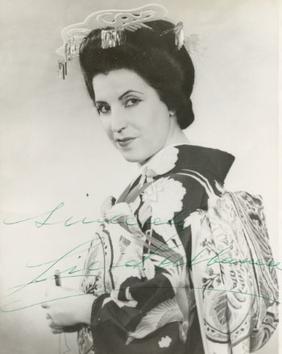
Licia Albanese was an Italian-born American operatic soprano. Noted especially for her portrayals of the lyric heroines of Verdi and Puccini, Albanese was a leading artist with the Metropolitan Opera from 1940 to 1966. She also made many recordings and was chairwoman of The Licia Albanese-Puccini Foundation, which is dedicated to assisting young artists and singers.
Alfredo Antonini was a leading Italian-American symphony conductor and composer who was active on the international concert stage as well as on the CBS radio and television networks from the 1930s through the early 1970s. In 1972 he received an Emmy Award for Outstanding Achievement in Religious Programming on television for his conducting of the premiere of Ezra Laderman's opera And David Wept for CBS television during 1971. In addition, he was awarded the Order of Merit of the Italian Republic in 1980

Viva América was an American musical radio program which was broadcast live over the CBS radio network and to North and South America over the "La Cadena de las Américas" during the 1940s (1942–1949) in support of Pan-Americanism during World War II. It was also broadcast for the benefit of members of the armed forces in Europe during World War II over the Armed Forces Network. All broadcasts of this program were supervised under the strict government supervision of the United States Department of State and the Office of the Coordinator of Inter-American Affairs (OCIAA) as part of the United States Cultural Exchange Programs cultural diplomacy initiative authorized by President Franklin D. Roosevelt during World War II through the Office for Coordination of Commercial and Cultural Relations (OCCCRBAR), and the Office of the Coordinator of Inter-American Affairs directed by Nelson Rockefeller.
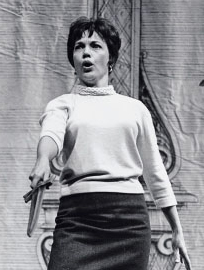
Beverly Wolff was an American mezzo-soprano who had an active career in concerts and operas from the early 1950s to the early 1980s. She performed a broad repertoire which encompassed operatic and concert works in many languages and from a variety of musical periods. She was a champion of new works, notably premiering compositions by Leonard Bernstein, Gian Carlo Menotti, Douglas Moore, and Ned Rorem among other American composers. She also performed in a number of rarely heard baroque operas by George Frideric Handel with the New York City Opera (NYCO), the Handel Society of New York, and at the Kennedy Center Handel Festivals.
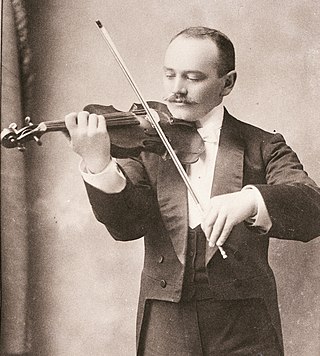
Arnold Volpe was a Russian-born American composer and conductor. He composed mainly chamber music, including a string quartet, as well as a mazurka for violin and orchestra. He founded both the Lewisohn Stadium Concerts in New York City and the symphony orchestra at the University of Miami, and he conducted five productions for the Washington National Opera, a semi-professional company founded in 1919 and not associated with its current namesake, beginning late in its first season. He was related to the composer Stefan Wolpe.

Betty Allen was an American operatic mezzo-soprano who had an active international singing career during the 1950s through the 1970s. In the latter part of her career her voice acquired a contralto-like darkening, which can be heard on her recording of Sergei Prokofiev’s Alexander Nevsky with conductor Eugene Ormandy and the Philadelphia Orchestra. She was known for her collaborations with American composers, such as Leonard Bernstein, Aaron Copland, David Diamond, Ned Rorem, and Virgil Thomson among others.
Eva Likova was an American operatic soprano of Czech descent. She was notably one of the major sopranos at the New York City Opera during the company's early years. She also made guest appearances with a number of opera houses in North America and Europe, enjoying a particularly fruitful partnership with the Philadelphia Grand Opera Company. After retiring from the opera stage in 1966, she embarked on a second career as a voice teacher.
Florence Kirk was an American dramatic soprano who had an active international performance career in operas and concerts from 1937 to 1954. Born in Philadelphia and trained at the Curtis Institute of Music by Elisabeth Schumann, she was particularly associated with the roles of Donna Anna in Mozart's Don Giovanni and the title heroine in Verdi's Aida. Her repertoire included other Verdi heroines like Leonora and Lady Macbeth, Santuzza from Mascagni's Cavalleria rusticana, Minnie in Puccini's La fanciulla del West and the title role in Tosca, and several roles from Richard Wagner's Ring Cycle.
Miguel Angel Sandoval Cabrera, was a Guatemalan-born American pianist, conductor and composer. He spoke Spanish, English, French, and Italian. His musical works contributed greatly to both countries, and he is viewed as a musical ambassador of Guatemala.















